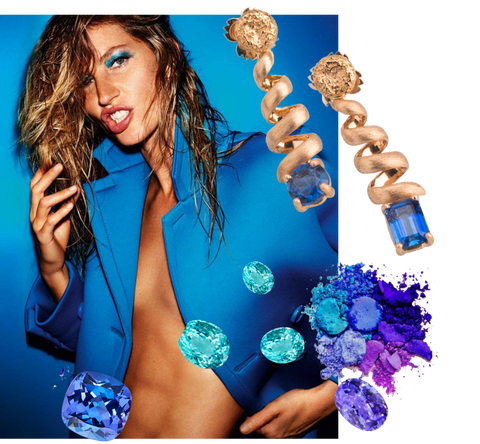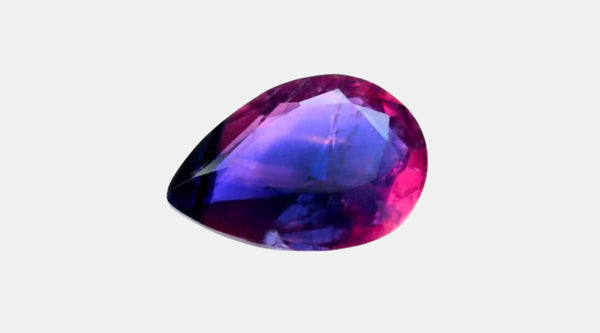What Is a Blue Sapphire?
KNOW YOUR STONES
What is a blue sapphire?
For those curious to discover what a blue sapphire is actually made of, what gives the stone its famed celestial blue color and the right thing to say when buying your sapphire, this post is for you.
Let’s dive in!
What is a blue sapphire made of?
Blue sapphire is the blue gem variety of corundum.
It consists of the chemical components of aluminum oxide plus the chemical components of iron and titanium. And in case you didn’t know it yet, sapphire and ruby actually belong to that same family of corundum! When corundum is red, it’s called a ruby. When corundum comes in any color than red, we call it a sapphire and we add the colour prefix in front of it.
In fact, sapphire can come in a variety of beautiful colors. There is more than the blue sapphire though that one has a special place in stone heaven! Some of the colorful varieties in the sapphire gang are:
The blue sapphire, the pink sapphire, green sapphire, white (or colorless) sapphire, yellow, orange, purple, the pink-orange variety (so wonderful it deserves its own post...), violet and some mixes in between.
But a red sapphire? Nope, that doesn’t exist. We call that a ruby.
Where does the gem get its blue color from?
As I described before, blue sapphire consists of the chemical components of aluminum oxide plus the chemical components of iron and titanium. It is those last two elements of iron and titanium that are responsible for the colour blue. That type of 'color causing' elements is also called the “trace elements”.
Now most corundum contains “trace elements”.
In ruby and pink sapphire, the trace element responsible for the colors red and pink is chromium. And in blue sapphire, the trace elements that cause its blue color are iron and titanium.
Interestingly enough, you only need a few hundredths of a percent of iron and titanium to cause the colour. The more iron the corundum contains though, the darker the blue will be and the less attractive it becomes…
In its purest state, corundum is colorless or white. So these gemstones don’t have any of those trace elements that normally cause the gem’s color.
Fun Fact: Colorless sapphires were once popular diamond imitations. And in recent times, have been making a comeback - as they are beautiful, have great brilliance and are a less expensive diamond alternative. But don’t get your hopes up too high as… they’re quite rare these days! More rare than diamonds actually (though diamonds do remain more expensive… but I’ll save that confusion for another post 🤓).

One simple buying tip for the interested buyer
Many people talk of simply “sapphire”. And although jewelers or gem dealers will understand that you probably mean the blue sapphire by that, it’s better to always add the colour pre-fix in front.
So, instead say: blue sapphire, pink, purple, orange sapphire, etc. Just so the vendor knows for sure which colour from the sapphire colour box you’re referring to!
Fancy and phenomenal parties?
There are some other ways gem dealers and jewelers use to classify sapphires. For instance, you may come across the term fancy sapphires. By that, what is meant in the trade is all the colored sapphires except the blue ones.
Then there are what is called parti-colored sapphires. These are special stones that have different colors within the same sapphire. They can come with two different colors - the bicolor sapphires - or with more colors even. Incredibly original!

Left: bicolor Ceylon sapphire, Finewater Gems;
Right: bicolor or parti-color Australian sapphire, John Dyer Gems.

Stunning bicolor sapphire, sapphirebazaar.com
And yet another unique group is the color-change sapphire. These special gems are actually "phenomenal" stones. I don’t mean ‘amazing and exceptional’ in the literary sense here (although they obviously are) but these are stones with what's called a gemological phenomenon.
Color change is the phenomenon in some sapphires whereby, for instance, a blue sapphire changes from blue in daylight or fluorescent light to purple into incandescent light (under a light bulb). Quite spectacular.

Colour-changing sapphire stunners from Vlad Yavorskyy.
Especially when the color change is noticeably going from one clear color to the other by simply subjecting the stone to another lighting source. See the wonderful stone from gem dealer Yavorskyy above.
High-end, premium stones have the best remarkable color change instead of it being a more subtle shift. This type of stones is hunted on by gem connoisseurs and they are rare (a nice way of saying that you need to bring your wallet 😉).
💎💎💎💎💎
For more gem stories and insider tips on how to buy your own investment-worthy gemstones, follow me on Instagram @evagemsandjewels.
I hope the above helps you on your gemstone piece journey and if you need any help in sourcing a special colored gemstone (like a fine blue sapphire) or with creating your own bespoke gemstone (engagement) ring, feel free to contact me to book a private consultation.







